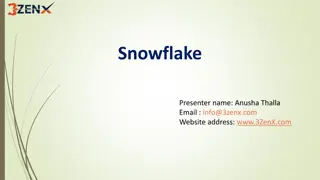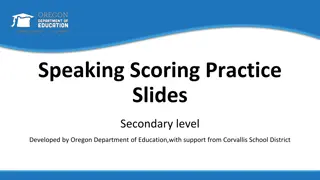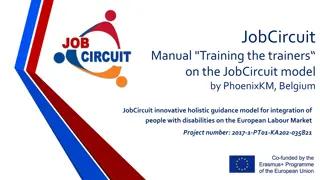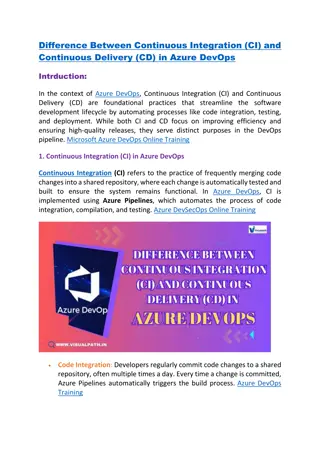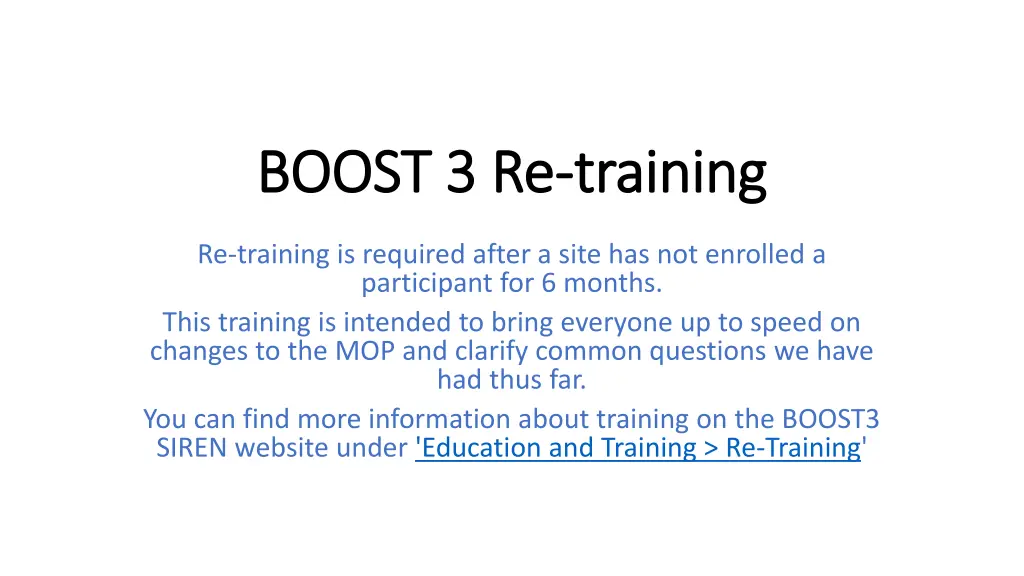
Study Enrollment Procedures and Eligibility Criteria
Learn about the essential training required for site personnel in the BOOST3 trial, guidelines for screening TBI patients, inclusion and exclusion criteria, and enrollment procedures with EFIC or signed consent. Stay informed to ensure compliance and successful study participation.
Download Presentation

Please find below an Image/Link to download the presentation.
The content on the website is provided AS IS for your information and personal use only. It may not be sold, licensed, or shared on other websites without obtaining consent from the author. If you encounter any issues during the download, it is possible that the publisher has removed the file from their server.
You are allowed to download the files provided on this website for personal or commercial use, subject to the condition that they are used lawfully. All files are the property of their respective owners.
The content on the website is provided AS IS for your information and personal use only. It may not be sold, licensed, or shared on other websites without obtaining consent from the author.
E N D
Presentation Transcript
BOOST 3 Re BOOST 3 Re- -training training Re-training is required after a site has not enrolled a participant for 6 months. This training is intended to bring everyone up to speed on changes to the MOP and clarify common questions we have had thus far. You can find more information about training on the BOOST3 SIREN website under 'Education and Training > Re-Training'
Screening Screening Screen all patients who are in the ED or admitted to an ICU with a TBI and will have placement of an intracranial monitoring device. Screening reports need to be submitted in WebDCU within 5 days of the date of screening.
Eligibility Inclusion criteria for the study that have raised some questions: (These are not all of the criteria for eligibility) 1) Intracranial monitors will be placed within 6 hours of arrival at the enrolling hospital, but no later than 12 hours after the injury. Keep track of these timeframes as you work on the enrollment of a participant. 2) Criterion: Patient is greater than or equal to 14 years of age. If you are not sure of the child s age, you must confirm with a family member, medical record, school ID or driver s license. (not a friend) 3) A Glasgow Coma Score (GCS) of 3 8 measured off paralytics and sedation after resuscitation with a motor component score less than 6 in intubated patients. Use the GCS closest to time of randomization.
Exclusion criteria for the study with caveats: (These are not all of the criteria, but some that have raised some questions answered here:) *Refractory hypoxia prior to randomization take two consecutive readings at least 5 minutes apart). The following explanations and clarifications indicate how this should be interpreted in determining eligibility; *Transient hypoxia that is not sustained does not warrant exclusion. *There is no requirement that a blood gas be obtained prior to randomization.
Enrollment with EFIC or Signed Consent If no LAR is available prior to placement of the ICP and brain tissue oxygen monitors, the patient may be enrolled under EFIC. E.g. by time they are prepping the patient, use that as probe placement timestamp so that it precedes randomization. If an LAR is known to be available prior to ICP and brain tissue oxygen monitors being placed, consent will be sought from the LAR. If the LAR is present and signs consent (or eConsent) it is ok to randomize the patient before the probe is placed. If a patient is enrolled under EFIC, the time recorded for probe placement must be prior to the time- stamp of randomization. E.g. The time of probe placement can be the time at the beginning of the procedure. It does not have to be the time noted in the medical record since that time is sometimes the time recorded after all procedures in the OR were completed. Have the surgeon just tell you what time the procedure was started. .
Do I use EFIC or signed Consent? Do I use EFIC or signed Consent? Q: We understand that we can only enroll with prospective consent, and cannot enroll with EFIC, when a family member/LAR is physically available at the hospital prior to probe placement, but how do you define available ?Could an LAR be physically present, but not available ? Could being emotionally distraught make an LAR un-available even if physically present prior to probe placement? A: It is recognized that family members sometimes arrive prior to probe placement but clearly have no capacity to act as a legally authorized representatives. Examples of this include when the family members present were also critically injured in the same accident, when they are minors, when they are demented or developmentally delayed, or (more difficultly) when very intoxicated. *** Nothing in the preceding or following discussion is intended to apply to an LAR that is situationally impaired. While it is recognized that family members are often emotionally impaired such that they have difficulty participating in informed consent processes, we do not feel that this condition can ever abrogate one from being an LAR. Subjects should never be permitted to be enrolled under EFIC when an LAR is present, even if the emotional state of the LAR delays the informed consent discussion. ***
Allowing EFIC enrollments when family members lack capacity removes the temptation to try to enroll subjects that would otherwise be lost by obtaining consent from family members that cannot meaningfully or legally engage in a consent process. At the same time we recognize that this interpretation creates a temptation to determine that the family lack capacity to serve as LAR in order to allow enrollment under EFIC. This is largely mitigated by the requirement that consent still needs to be obtained as soon as possible after an EFIC enrollment, and it is anticipated that enrollments of this type will be rare. To ensure accountability, sites must use the on-call PI hotline 855-4-BOOST3 (855-426-6783) if they ever want to enroll under EFIC when an LAR is physically present but deemed by the team unavailable to participate in a consent process. Also, if a site enrolls under EFIC when an LAR was physically present, they will be asked to subsequently present the case on a conference call to either the BOOST executive working group and/or the SIREN HSP working group. The intent is to make sure this rule is being interpreted correctly, and to make sure these interpretations are highly transparent and can be tracked.
CAVEATS: When an LAR Refuses If the LAR refuses randomization and the patient was already enrolled under EFIC and receiving treatments under the study protocol, when the Investigator or staff member discusses the study with the LAR, they should ask AT THAT TIME if the study may continue to monitor and collect the data without randomizing. If an LAR refuses to let a patient be randomized but will allow us to collect data, the patient will have the 6-month follow-up if the LAR allows this. This is part of intent to treat principles.
ENROLLMENT EFIC or LAR WRITTEN CONSENT WRITTEN OR eCONSENT ENROLLMENT EFIC ENROLLMENT 1. Probes not placed and LAR present 1. Probes being placed and no LAR 2. LAR contacted before probes placed and has computer access and wants to sign Consent 2. LAR on Phone and not objecting 3. LAR present and unable to sign but not objecting Continue to try to get signed Consent or eConsent. 3. Probes may be placed after signed Consent
Common issue that has happened: ***The LAR is not at the hospital and does not have access to a computer for eConsent, but you are able to make contact (e.g. by telephone or even in person but they are too upset to sign at that time), as long as the LAR does not object to the patient s participation, the patient may be enrolled under EFIC. Document that the LAR did not object to the patient being in the study. Continue to try to obtain written consent or eConsent. Note: The timestamp on the eConsent may be Eastern: make note to file that clarifie.d the time zone if needed.
Randomization Randomization You will need to complete the following forms in WebDCU before the patient can be randomized: BOOST-3 web-based system is https://webdcu.musc.edu/. Log in with your personal user name and password. 1. Subject Enrollment Form 2. Baseline Glasgow Coma Scale (Form 138) 3. The Inclusion and Exclusion Criteria (Form 101) forms, with all eligibility criteria met. 4. Complete and submit the Randomization Form (form 102) WebDCU algorithm will evaluate eligibility. Estimating age as accurately as possible is very important for us to define severity. Some have been off by 30 years or more!
When Does Day 1 Begin and End Day 1 begins at the time of Randomization. This is true even if the time is just before midnight. Example: Randomize patient on August 1 at 22:30. Day 1 Form begins with August 1 at 22:30. Day 2 begins at 00:01 on August 2, in this example. Each day is a 24 hour period. Data will be collected for 120 hours through Day 6 Form on August 6 at 22:30. All patients will have a Day 6 Form for at least part of the day.
Study Intervention Overview 1. Patients will be randomized to one of two treatment groups: ICP-only treatment group (control group) or ICP plus PbtO2 treatment group 2. Intracranial Monitors used in this study are Raumedic or Licox PbtO2 monitors. 3. Monitoring and following the participant will continue for up to 5 days (120 hours) from the time of randomization. 4. Probes may be removed if the patient starts following commands, has normal ICP and PbtO2 values for 72 hours, or after the 5-day (120-hour) study period. (The PbtO2 value is not taken into account in the ICP-only arm.) The treating physician may decide to keep the probes in past the 5-day period for clinical reasons.
5. Management of ICP and PbtO2 is directed by Tier- based therapies. Treatments will be triggered when there is a rise in ICP above 22 mm Hg or a fall in PbtO2 below 20 mm Hg. 6. The Moberg sounds an alarm after the abnormality is sustained for 5 minutes. An intervention must be initiated within 15 minutes from the beginning of the abnormality. The treatment team may begin treatment sooner than 5 minutes if they notice an abnormality. 7. The control group will receive standard care (based on ICP driven interventions alone. The display of PbtO2 values will be masked, making the display accessible only to study coordinators. Do not unblind the PbtO2 values to the treatment team in the ICP-only group.
Forms to be completed through the 5-day (120-hour) Day 6 Form period if the monitors are removed before that time: Technically you must complete all forms, but some will not be available. FiO2 challenge put NO and comment F104 Adverse Event F138 GCS F501 Glucose Log F502 Hemoglobin Log F503 Oxygen Saturation F504 Temperature F515 ABG Log that the monitors were removed earlier. Note in General Comments You do not need to collect data in CRFs past the Day 6 Form.
Assessing Reliability of the PbtO2 Probes FiO2 challenges: Perform an FiO2 challenge within 2 hours after placement of the PbtO2 probe, and daily thereafter until it is removed. If you cannot do the challenge because the patient is in the OR, for example, do the challenge as soon as is possible and note in Comments in WebDCU that the patient was not accessible. Document as protocol deviation. Treatment staff will be blinded to the results of the FiO2 challenge in the ICP-only group.
FiO2 Challenges FiO2 Challenges (continued) The expected response to a FiO2 challenge would be a PbtO2 increase of at least 5 mm Hg within 20 minutes of FiO2 at 100%. If the initial challenge on Day 1 does not show the expected response, a repeat challenge should be done within 1 hour. If the change is < 5 mmHG within 20 minutes, the challengehas failed. Do it again within 1 hour. If the challenge fails, change is < 5 mmHG within 20 minutes, further managment is determined by treatment group. For ICP + PbtO2 a head CT must be obtained to confirm placement, and the probe will require replacement if non functional. On subsequent days (after Day 1), if the initial challenge fails, the treating physician may determine when or whether to perform further challenges.
FiO2 Challenges FiO2 Challenges (continued) In case the ventilator is already set at 100% FiO2, how can you do an FiO2 challenge? May perform a blood gas to determine the safety of lowering the FiO2 temporarily for the FiO2 challenge. If it is not feasible to lower the FiO2, may do a MAP or CO2 challenge. A MAP or CO2 challenge should not be performed in subjects in the ICP- only group. If the second FiO2 challenge again fails, further management will be determined by patient group. 1.In the ICP+PbtO2 (intervention) group, a non-functioning or mal-positioned PbtO2 probe should be replaced within 2 hours if at all possible. 2.In the ICP only (control) group, the study team will document that the PbtO2 probe is unreliable but will not replace it. Do not inform the treatment team that the probe is malfunctioning in a blinded patient. 3. You may check the FiO2 daily in case it begins to function. This happens.
Caveat: Questioning if the PbtO2 probe is working (Perhaps you see weird numbers on the monitor). A PbtO2 range of 0-100 mmHG is generally believable. If it is greater than 100 mmHG, reliability of the probe is questionable. If the treating physician thinks that the probe is malfunctioning, it is not necessary to perform the Daily FiO2 Challenge. Enter a comment in the Moberg CNS and CRF that the determination was made/supported by the local PI. In WebDCU where it asks about the Daily FiO2 Challenge, check No (not done) and enter a comment that the probe appeared to be malfunctioning. Note that if this pt is in ICP + PbtO2 treatement group, then a CT will need to be obtained and/or probe will require replacement.
Definition of an Episode Elevations in ICP greater than 22 mmHg, or a decline in PbtO2 below 20 mmHg, which are sustained for more than 5 minutes cause the Moberg to sound an alarm. Although 5 minutes of abnormal values are required to confirm a sustained abnormality prompting an intervention, the actual start of an Episode is defined as the time when the value first exceeded the target value. An Episode ends when an abnormality is treated and has resolved with normal values occurring for a duration of 30 minutes. If another abnormality begins after 30 minutes of normality, a new Episode begins and the treatment team should again begin in Tier 1. If an ICP or PbtO2 is corrected and then becomes abnormal again within 30 min. treat as one Episode. May select treatments from any Tier at that point.
Definition of an Episode (continued) Exception: If the treatment team is already working in Tier 2 when a new Episode begins, and the clinicians deem it unreasonable or inadvisable to re-visit Tier 1 treatments (e.g., HOB is already elevated, CSF drainage utilized, and others), then it is acceptable not to begin treatment of the new Episode with Tier 1 choices. Participants may start in one type of episode and move to another. Participants randomized to ICP + PbtO2 treatment may fall into any of the 4 scenarios, B, C, or D and ICP-only group will use treatments from Tier B. For example: A patient in the PbtO2 tx group spikes a high ICP. This triggers a Scenario B ICP treatment. While treating the abnormal ICP, the PbtO2 suddenly drops below 20 and the Carepath triggers a D Scenario, in which there are selections of treatments for both types of abnormalities. If the ICP becomes normal, the Carepath may jump to a C Scenario with selections only for abnormal PbtO2. The Carepath is trying to keep the team focused on the value that is abnormal at that time. It may be confusing. Remember that for an Episode to be completed, there needs to be 30 minutes of normal value from the abnormality resolved.
Treatment Tiers Treatment strategies are divided into Tiers A,B,C,D. It is not necessary to use all treatments in the Tier if it is judged by the treating physicians that a particular intervention is contraindicated in an individual participant. It is expected that at least one intervention from each Tier will be used before proceeding to the next Tier. Begin in Tier 1 and move to Tier 2 as quickly as you like. May work between the 2 Tiers at the same time, using treatments from both, but begin with something from Tier 1. You must move to Tier 2 within 60 minutes if Tier 1 treatments are not working. Tier 3 treatments are optional.
Adverse Event Reporting: When to report SAEs: Only SAEs are collected and assessed throughout the participant s 6 month participation in the trial. For SAEs, the data entry into WebDCU must take place within 24 hours of discovery of the event. AEs: Collect Adverse Events only during the first 120 hours from randomization or until hospital discharge, whichever comes first.
Subject Tracking and Follow-Up Research staff who obtain the outcome measures must be blinded to group assignment. Participants must be followed daily by study staff while hospitalized in the ICU. Collect multiple phone numbers, email and home addresses for the participant and family members in order to attain a high rate of follow-up. Get address and number for facility. At discharge from the hospital, let the participants know that study staff will contact them by telephone about once per month until their 6-month follow-up visit. Obtain contact information with the discharge location i.e., home, assisted living, SNF etc. Ask them to keep the consent with them if they go to a facility. Subjects cannot be deemed Lost to Follow Up without BOOST 3 Operations Committee approval. The site PI must present a case to the Operations Committee that includes the efforts exerted to locate the study subject. Study staff will arrange the 6-month follow-up assessment. The Central Examiner will administer the GOS-E to the participants at all sites by phone. Local blinded outcome examiner will administer the other questionnaires and forms.
Follow-up (continued) Phone number for texting Central Examiner is 833-365-5693. Local study staff member will confirm the appointment with the participant. Appointments will be arranged between the Local blinded outcome examiner and the Central Examiner using the Central Examiner Google Calendar. If the patient is unable or unwilling to come to the clinic for an in-person visit at the approximate 6-month time point, the Central Examiner may still administer the GOS-E, by telephone with participant or someone knowledgeable about their functional level. If there is NOT an in-person visit planned, the local blinded outcome examiner may administer follow-up questionnaires by telephone.
A Few Highlights The definition of 5 days is equivalent to 120 hours from the time of randomization. You will need to complete 120 hours of data collection and entry in WebDCU through part or all of Day 6 form. (Even if the Moberg and monitoring devices have been removed before the 5-day period, continue to collect information through the 120-hour period.) Forms to be completed through the 5-day (120-hour) period if the monitors are removed before that time: F104 Adverse Event, F138 GCS, F501 Glucose Log, F502 Hemoglobin Log, F503 O2 Saturation, F504 Temperature, F515 ABG.
Highlights (continued) Highlights (continued) Counting burr holes for entry of numbers in WebDCU: Count all burr holes, including EVD. If any probes are replaced, also count those burr holes that are newly drilled. Episode: An episode is defined as the period between the beginning of an abnormal ICP or PbtO2 and a 30 minute period of normal values. After the 30 minutes of normalcy, if a new abnormality occurs, a new episode begins. Always treat a new episode beginning in Tier 1. Exception: If there are already treatments on board from Tier 2 when a new Episode begins, and the clinicians deem it unreasonable or inadvisable to re-visit Tier 1 treatments, then it is ok to begin new treatments from Tier 2. Last thing: PLEASE KEEP YOUR MOBERG BOX IN WHICH IT WAS SHIPPED
Important Links BOOST-3 Website Getting Started Education and Training Toolbox FAQs WebDCU


